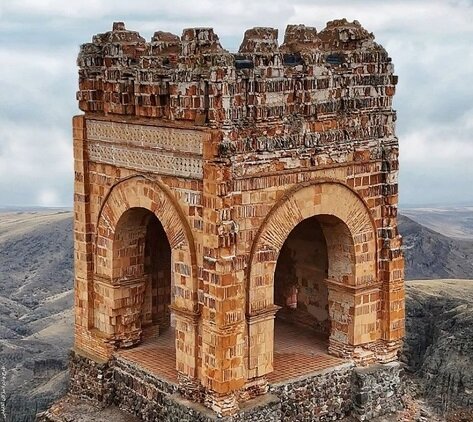Zahhak Castle’s significance to be discussed in special conference

TEHRAN – An inaugural conference on the historical and cultural significance of Zahhak Castle, will be held on December 18 in Hashtrud of East Azarbaijan province, where the ancient fortress is situated in northwest Iran.
According to organizers, several distinguished scholars and experts in history, architecture, and cultural heritage have been invited to discuss the castle’s unique features, its conservation needs, and sustainable methods for its utilization as a tourist destination.
The landmark event is set to turn the spotlight on the role of the elevated fort and its connection with the Parthian Empire (247 BC–224 CE) and its broader impact on the history of the Azarbaijan region.
The conference is organized through the joint efforts of several key organizations, including the Revitalization and Utilization Fund for Historical and Cultural Sites, the East Azarbaijan Department of Cultural Heritage, Tourism, and Handicrafts, Tabriz Islamic Art University, Hashtrud Governorate, and the Research Institute of Cultural Heritage and Tourism.
Zahhak Castle, named after the mythical figure Zahhak from ancient Iranian mythology, dates back to the second millennium BC, with continued occupation through the Timurid era (1370–1507).
The fortress, which features intricate brickwork, archways, and staircases, offers insights into ancient defensive architecture and societal structures.
Historical and archeological significance
The castle’s strategic importance during the Parthian period is underscored by historical accounts, including its role in the defeat of Roman general Marc Antony in 37 BC. The Median infantry, allied with the Parthian cavalry, played a crucial part in this victory, providing a rare glimpse into the military strategies of the era.
Archaeological excavations, initiated by British researchers decades ago, have revealed artifacts such as stucco remnants with traces of coloring, shedding light on the site’s artistic and cultural heritage.
Future prospects
The conference is intended to suggest new initiatives to transform Zahhak Castle into a sustainable tourism destination. Proposed plans included the introduction of preservation programs, community involvement in conservation efforts, and marketing campaigns to boost regional and international tourism.
Organizers said by bringing together scholars, policymakers, and local stakeholders, the event is aimed to ensure the preservation of this unique historical site while fostering economic growth in the region.
Glimpses of Parthian era
The Parthian Empire, also known as the Arsacid Empire, was a major Iranian political and cultural power centered in ancient Iran from 247 BC to 224 CE. Its name derives from its founder, Arsaces I, who led the Parni tribe in conquering Parthia, a northeastern region of Iran. At the time, Parthia was a satrapy (province) under Andragoras, a rebel against the Seleucid Empire.
At its zenith, the Parthian Empire extended from the northern Euphrates River (modern central-eastern Turkey) to present-day Afghanistan and western Pakistan. Positioned along the Silk Road, the empire thrived as a hub for trade and commerce, connecting the Roman Empire in the Mediterranean to the Han dynasty in China.
The Parthians assimilated various elements of the diverse cultures within their empire, which included Persian, Hellenistic, and regional influences. Initially, the Arsacid court adopted many aspects of Greek culture but gradually saw a revival of Iranian traditions. Parthian rulers adopted the title “King of Kings”, asserting their heritage from the Achaemenid Empire. Unlike the Achaemenids, who governed through centrally appointed satraps, the Parthians often allowed local kings to serve as vassals. As the empire expanded, its central government shifted from Nisa to Ctesiphon, near modern Baghdad, though other cities also served as capitals.
AM
Leave a Comment